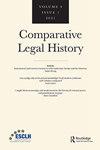Early modern privacy: sources and approaches
IF 0.5
Q2 LAW
引用次数: 0
Abstract
The website for the Danish National Research Foundation Centre for Privacy Studies informs users in a pop-up window that their actions will be shared with third parties to ‘keep improving our service’, and offers the opportunity to opt out of information-sharing via cookies. This near-universal web-browsing experience is, perhaps, one of the quotidian modern surrenders of privacy that motivates the work of the Centre for Privacy, and this volume of essays, to better define the roots of our ideas about privacy in the early modern age. Lars Cyril Nørgaard’s introduction asserts that examining the sources of the notion of privacy ‘allows us better to understand our current condition, where we seem of our own volition to give up on our right to privacy’ (3). The problem, of course, is how to bridge the distance between a period, 1500-1800, in which privacy was neither protected by law nor considered a universal aspect of the human condition, and our own, which often views privacy both as a human right increasingly threatened by technology, and as a commodity that may be casually forfeited at a price as low as dismissing an intrusive pop-up. The early modern period of 1500–1800 in Europe has been seen as crucial in the development of modern notions of privacy by many theorists, notably Jürgen Habermas, Norbert Elias, Philippe Ariès, and Georges Duby. For these thinkers, a new division between a private sphere linked to the home and the body, associated with emotion and intimacy, and a public sphere of surveillance linked to早期现代隐私:来源和方法
丹麦国家研究基金会隐私研究中心的网站在一个弹出窗口中通知用户,他们的行为将与第三方共享,以“不断改进我们的服务”,并提供选择不通过cookie共享信息的机会。这种近乎普遍的网络浏览体验,也许是现代人对隐私的日常放弃之一,这激发了隐私中心的工作,以及这本文集,以更好地定义我们在现代早期对隐私的看法的根源。Lars Cyril Nørgaard在引言中断言,研究隐私概念的来源“可以让我们更好地理解我们目前的状况,我们似乎自愿放弃我们的隐私权”(3)。当然,问题是如何弥合1500-1800年间隐私既不受法律保护,也不被视为人类状况的普遍方面与我们自己之间的距离。他们常常认为隐私既是一项日益受到科技威胁的人权,也是一种可以随意丧失的商品,代价低得就像解雇侵扰性的弹出式广告一样。1500-1800年的欧洲早期现代时期被许多理论家视为现代隐私概念发展的关键时期,尤其是j根·哈贝马斯、诺伯特·埃利亚斯、菲利普·阿里斯和乔治·杜比。对于这些思想家来说,一种新的划分,私人领域与家庭和身体有关,与情感和亲密有关,公共领域与监视有关
本文章由计算机程序翻译,如有差异,请以英文原文为准。
求助全文
约1分钟内获得全文
求助全文
来源期刊
CiteScore
1.70
自引率
0.00%
发文量
20
期刊介绍:
Comparative Legal History is an international and comparative review of law and history. Articles will explore both ''internal'' legal history (doctrinal and disciplinary developments in the law) and ''external'' legal history (legal ideas and institutions in wider contexts). Rooted in the complexity of the various Western legal traditions worldwide, the journal will also investigate other laws and customs from around the globe. Comparisons may be either temporal or geographical and both legal and other law-like normative traditions will be considered. Scholarship on comparative and trans-national historiography, including trans-disciplinary approaches, is particularly welcome.

 求助内容:
求助内容: 应助结果提醒方式:
应助结果提醒方式:


